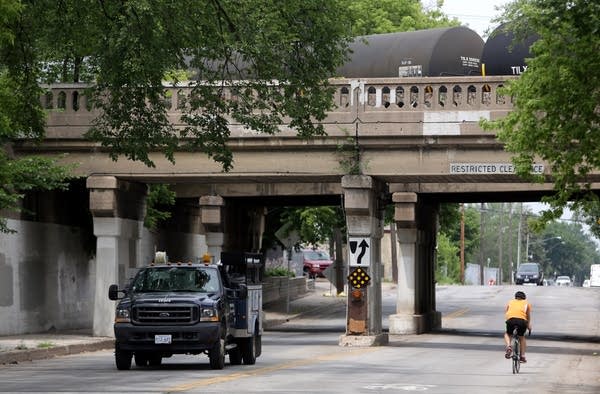Oil train traffic jumps in downtown Minneapolis

BNSF has sharply increased the number of trains loaded with North Dakota crude oil passing through downtown Minneapolis. The railroad says it's only temporary, but the move has city leaders concerned.
Normally, the railroad sends most of its oil trains south through Anoka County and into Northeast Minneapolis, across the river from downtown. But in July, it began shifting those trains to another route that passes through the western suburbs and goes along the edge of downtown.
In June, no more than three oil trains on average traveled that corridor each week. By mid-September, the number had jumped to between 11 and 23. Each carried 1 million or more gallons of flammable crude oil right by Target Field.
"It's a huge concern," said state Rep. Frank Hornstein, D-Minneapolis. He said he was at a Minnesota Twins game at Target Field earlier this season and saw three oil trains in six innings.
Create a More Connected Minnesota
MPR News is your trusted resource for the news you need. With your support, MPR News brings accessible, courageous journalism and authentic conversation to everyone - free of paywalls and barriers. Your gift makes a difference.

"The National Transportation Safety Board has said that these kind of trains should be rerouted away from densely-populated areas," Hornstein said. "This does present a risk to the public."
BNSF says the trains will return to their regular routes later this fall, once a major track construction project wraps up, though Hornstein notes that they'll still travel through parts of Minneapolis and the northern suburbs where lots of people live.
Freight trains employ a variety of precautions when they pass through populated areas, including a voluntary 35 mph speed limit, BNSF spokesperson Amy McBeth said. The industry, she added, is constantly working to improve safety.
"Through things like reduced speed, increased track inspection, more trackside technology, and now with the safer tank cars that will be coming online, we've taken some significant steps that we know will further reduce risk," she said.
Hennepin County Emergency Management Director Eric Waage first learned about the increase in downtown Minneapolis oil train traffic from a news story Wednesday morning in the Minneapolis Star Tribune.

The temporary re-route raises concerns, but the county needs to be prepared for train disasters no matter where they happen, he said.
"We don't want to over-focus on one product, on one carrier, on one line," Waage said. "If there are any kind of transportation methods that are carrying hazardous materials, we want to make sure we have the capability and capacity to respond to all those kind of things."
Last year, Minnesota enacted a new law designed to improve the state's capability to respond to an oil train derailment. So far, more than 3,000 first responders have received training as a result.
Hornstein, who championed that initiative, says more needs to be done.
"We have to do all we can to prevent an accident from happening," he said, noting an oil train wreck in Quebec, Canada two years ago that exploded and killed 47 people. "It's only by sheer dumb luck that the other explosions of oil and ethanol trains that have taken place since then haven't had fatalities."
The Twins don't view the jump in oil car traffic near the stadium as a big problem.
"Target Field was designed to accommodate an active railway. Safety precautions were a huge part of that design," said team spokesperson Kevin Smith. "While our preference would be for less of this specific type of rail traffic through the ballpark corridor, the Twins do not view it as a significant concern."